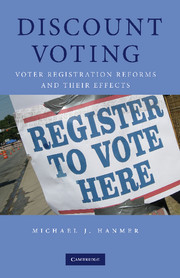Book contents
- Frontmatter
- Contents
- Acknowledgments
- Introduction
- 1 Motivation and a New Theoretical Framework
- 2 The Purposeful Adoption of Election Day Registration
- 3 Election Day Registration by Choice and by Federal Mandate
- 4 Motor Voter by Choice and by Federal Mandate
- 5 Registration and Voting in the Post-NVRA Era
- 6 Election Reform and the Composition of the Electorate
- 7 EDR on the Ground and Prospects for the Future
- APPENDICES
- References
- Index
3 - Election Day Registration by Choice and by Federal Mandate
Published online by Cambridge University Press: 02 December 2009
- Frontmatter
- Contents
- Acknowledgments
- Introduction
- 1 Motivation and a New Theoretical Framework
- 2 The Purposeful Adoption of Election Day Registration
- 3 Election Day Registration by Choice and by Federal Mandate
- 4 Motor Voter by Choice and by Federal Mandate
- 5 Registration and Voting in the Post-NVRA Era
- 6 Election Reform and the Composition of the Electorate
- 7 EDR on the Ground and Prospects for the Future
- APPENDICES
- References
- Index
Summary
When studying the effect of electoral reform, including election day registration (EDR), in order to obtain point estimates of the effect of the policy program, researchers impose the exogenous selection assumption, which treats the selection of election laws as a random process. Thus, it follows that once the new laws are implemented, citizens in states with traditionally low levels of participation (and thus low levels of factors that affect participation, such as political interest) will act the same as those in states with high levels of participation. As discussed in Chapter 1, this view is flawed. However, researchers have attacked the study of electoral reform without full recognition of the consequences of imposing such an assumption.
When using individual-level data to study EDR, one usually proceeds in four steps: 1) run a traditional logit or probit model on a binary dependent variable coded as 1 for those who voted and 0 for those who did not vote, with a variable for closing date and perhaps an indicator variable for EDR as the key independent variables; 2) set the values of the variables to indicate that EDR applies for all and calculate a predicted probability of voting for each individual; 3) set the values of the variables to indicate that EDR does not apply to anyone and calculate a predicted probability of voting for each individual; and 4) subtract the result obtained in step 3) from the result obtained in step 2) and then take the average to obtain an estimate of the effect of EDR. Implicit in this procedure is the imposition of the exogenous selection assumption.
- Type
- Chapter
- Information
- Discount VotingVoter Registration Reforms and their Effects, pp. 79 - 105Publisher: Cambridge University PressPrint publication year: 2009

